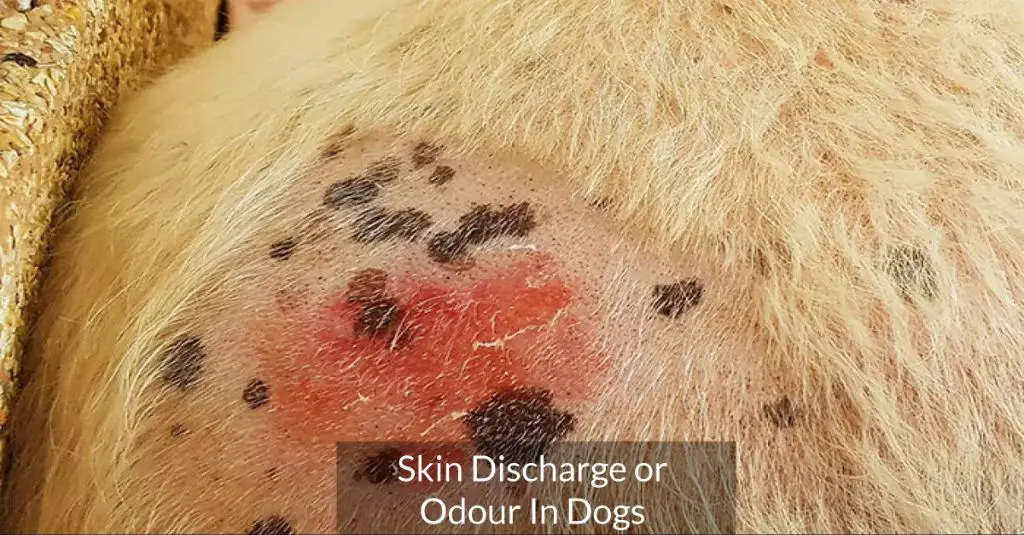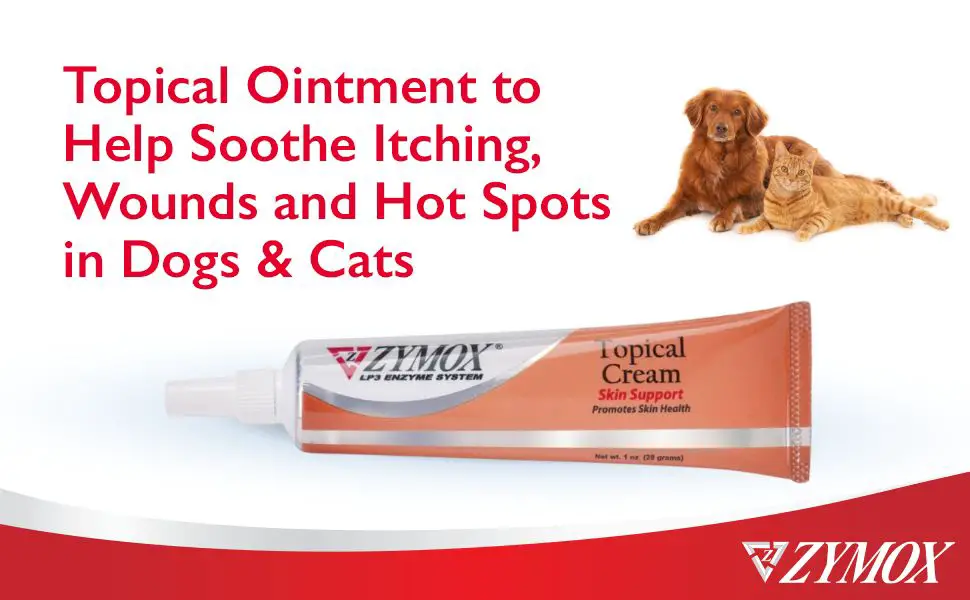Causes of Skin Infections in Dogs
Dogs can develop skin infections for a variety of reasons. Some of the most common causes include:
Bacterial infections – Bacteria like Staphylococcus and Streptococcus can infect the skin, leading to conditions like hot spots, folliculitis, and pyoderma. These infections cause redness, itchiness, pus, and crusty sores.

Fungal infections – Fungal organisms like Malassezia can overgrow on dogs’ skin, especially in areas with folds. This leads to itchy rashes and yeasty odors. Common fungal skin diseases include yeast dermatitis and Malassezia dermatitis.
Parasitic infections – Parasites like mites (sarcoptic, demodectic), lice, and fleas can infest a dog’s skin and cause severe itchiness, hair loss, and secondary infections. Dogs may scratch relentlessly and develop skin wounds.
Allergies – Both environmental and food allergies in dogs can manifest as skin problems like hives, itchiness, hot spots, and ear infections. Dogs with allergies have very sensitive skin that overreacts to allergens.
Symptoms of Skin Infections
Some common symptoms of skin infections in dogs include:
Redness – Red, inflamed skin is one of the most obvious signs of a skin infection. Redness indicates inflammation and irritation.
Itching – Most skin infections cause intense itching. The irritation leads dogs to scratch, lick and bite the affected areas, which can worsen the infection.
Hair loss – Hair loss, or alopecia, often occurs around infected areas. This is due to the inflammation damaging hair follicles.
Odor – Skin infections frequently produce a foul, pungent odor. This is caused by overgrowth of bacteria or yeast on the skin.
Crusting/scaling – Infections like mange can cause thick crusts or scales to develop on the skin surface. Flaky skin may also occur.
Hot spots – Also called acute moist dermatitis, hot spots are red, wet, irritated lesions. They are often seen in dogs with allergies and can be caused by self-trauma from biting, licking, and scratching.
Diagnosing Skin Infections
Getting an accurate diagnosis of your dog’s skin infection is important before beginning any treatment. There are several diagnostic tests a veterinarian may use:
Physical exam – The vet will thoroughly examine your dog’s skin, looking for any lesions, inflammation, hair loss, or other abnormalities. They will note the location and appearance of any lesions. This provides clues as to the type of infection.
Skin scrape/cytology – The vet takes a small sample of skin cells and examines them under a microscope. This can detect bacterial infections, yeast, and some parasites.
Fungal culture – For suspected fungal infections, the vet will take a skin or hair sample and culture it to see if fungus grows. This identifies the specific type of fungal infection.
Biopsy – In some cases, a small piece of skin may be removed and sent to a lab for analysis. A biopsy can detect fungal, bacterial and parasitic infections not found through other tests.
Once the underlying cause is determined through these diagnostic tests, the vet can recommend the most effective treatment options.
Topical Antibiotics

Topical antibiotics applied directly to the skin are commonly prescribed by veterinarians to treat bacterial skin infections in dogs. Some of the most effective topical antibiotic ointments for dogs include:
Mupirocin – This topical ointment contains the antibiotic mupirocin and is used to treat skin infections caused by staphylococcus bacteria like impetigo. Mupirocin kills bacteria by preventing the growth and spread of infection. It is applied to affected areas 2-3 times per day.
Neomycin – Neomycin is an antibiotic that works against a wide variety of bacteria. It is often combined with other medicines like polymyxin B and bacitracin in ointments used to treat bacterial skin infections, wounds, burns, ulcers and dermatitis in dogs. Neomycin ointments are applied thinly to affected skin 2-3 times a day.
Bacitracin – Bacitracin is a topical antibiotic that kills bacteria by interfering with cell wall and protein synthesis. It is primarily used against gram-positive bacteria. Veterinarians often prescribe bacitracin combined with neomycin and polymyxin B to treat bacterial infections on dogs’ skin. It should be applied 3-4 times daily.
Always follow your veterinarian’s dosage instructions when using topical antibiotic ointments on your dog. Using the ointment for the full course is important to completely eliminate the bacterial infection.
Antifungal Ointments
Antifungal ointments can be very effective for treating fungal skin infections in dogs. Some common antifungal ingredients to look for include:
- Miconazole – This ingredient disrupts fungal cell walls and inhibits growth. Miconazole is effective against various types of fungal infections. It comes in both over-the-counter and prescription strengths.
- Clotrimazole – Another common antifungal medication, clotrimazole works by inhibiting the growth of fungi on the skin. It is frequently used to treat yeast infections and ringworm in dogs.
- Ketoconazole – Available as a cream, foam, or shampoo, ketoconazole is a broad-spectrum antifungal. It prevents fungal cells from making ergosterol, an essential component of the fungal cell membrane.
Always follow label directions carefully when using these ointments. Monitor your dog for any side effects like irritation or excess licking of the area. See your vet if the infection persists or worsens.
Hydrocortisone Creams
Hydrocortisone creams can provide relief from itching and inflammation associated with skin infections in dogs. Hydrocortisone works as a mild steroid, reducing redness, swelling, and irritation on the skin’s surface. It does this by inhibiting the production and release of prostaglandins and leukotrienes, chemicals that are part of the inflammatory process.
Hydrocortisone creams like Cortizone-10 contain 1% hydrocortisone as the active ingredient. This concentration provides anti-inflammatory effects without being too strong for sensitive dog skin. The cream can be gently applied to affected areas of your dog’s skin, providing a soothing feeling as it relieves itchiness and inflammation. Since steroids can have side effects with prolonged use, hydrocortisone creams should only be used for short durations as recommended by your vet.
Hydrocortisone creams help calm down flare-ups of skin inflammation, promoting healing. They’re ideal for hot spots and localized itchy skin irritations. The effects work rapidly but are temporary. Follow your veterinarian’s guidelines on application and don’t overuse hydrocortisone, as dogs can absorb it through their skin. Monitor your dog’s skin infection to determine if the hydrocortisone cream is helping or if a different treatment may be needed.
Natural Remedies
In addition to traditional medications, there are some natural remedies that can help soothe and heal skin infections in dogs. Some popular natural options include:

Coconut Oil
Coconut oil contains lauric acid, which has anti-inflammatory and antimicrobial properties. Applying virgin coconut oil topically to the affected skin can help reduce inflammation and fight infection. It can also moisturize dry skin. Look for cold-pressed, unrefined coconut oil and apply a thin layer to the skin 2-3 times per day.
Apple Cider Vinegar
The acetic acid in apple cider vinegar makes it an effective antibacterial and antifungal agent. Mix a 50/50 solution of apple cider vinegar and water and use a cotton ball to apply it gently to the infected area 2-3 times per day. Rinse afterwards. It can help kill bacteria and yeast on the skin. Be careful not to get it in the eyes.
Aloe Vera
Aloe vera gel has soothing properties and can help calm inflammation and promote healing. Look for pure aloe vera gel and apply it to the affected areas of your dog’s skin. It helps moisturize the skin and provides various nutrients and compounds that fight bacteria and inflammation. Reapply several times a day.
Importance of Identifying Underlying Cause
While ointments can help treat a dog’s skin infection topically, it’s crucial to identify and address the root cause of the infection to prevent it from recurring. Skin infections can be secondary conditions triggered by allergies, hormonal imbalances, parasites, autoimmune diseases, and other primary health issues. Treating just the symptoms without getting to the source of the problem will likely lead to repeated infections down the road.
Some common underlying causes of canine skin infections include flea allergy dermatitis, food allergies, atopic dermatitis, yeast overgrowth, hypothyroidism, and bacterial or fungal infections. To get to the bottom of what’s causing your dog’s skin infection, your veterinarian can perform diagnostic tests such as skin scrapings, allergy testing, and bloodwork.
Once the underlying condition is identified and treated, the skin infection is less likely to return. So while topical remedies can help soothe and heal the skin, it’s essential to partner with your vet to pinpoint the root cause and develop a treatment plan targeting not just the symptoms but also the source of the problem. This comprehensive approach helps set your dog up for lasting skin health and prevents frustrating recurrent infections.
When to See a Veterinarian
Skin infections in dogs typically improve with at-home treatment, but there are some instances when you should take your dog to the veterinarian:
- Persistent infection that does not respond to topical treatment within 7-10 days
- Rapid worsening of symptoms or the infection spreading to other areas
- Systemic signs such as fever, lethargy, loss of appetite, or swollen lymph nodes, which may indicate a deeper infection
Seeing the veterinarian is especially important if your dog is elderly, immunocompromised, or has other medical conditions. Puppies also warrant quicker veterinary attention. Your vet can identify the underlying cause, provide prescription medications if needed, and offer guidance on better managing your dog’s skin health.
Caring for Your Dog’s Skin
Taking good care of your dog’s skin is essential for preventing and treating skin infections. Here are some tips:

Good Hygiene
Bathe your dog regularly using a gentle, hypoallergenic shampoo. Avoid over-bathing which can dry out the skin. Gently pat dry the skin and coat after baths.
Healthy Diet
Feed your dog a high-quality diet rich in omega fatty acids. These healthy fats promote skin and coat health. You can also give omega supplements.
Grooming
Brush your dog’s coat regularly to distribute skin oils and remove dirt and debris. Be gentle if your dog has sensitive or infected skin. Avoid harsh brushing.
Flea/Tick Control
Use monthly flea and tick preventatives prescribed by your vet. Fleas and ticks can lead to skin irritation, infections, and hot spots. Check your dog’s skin regularly for any signs of parasites.